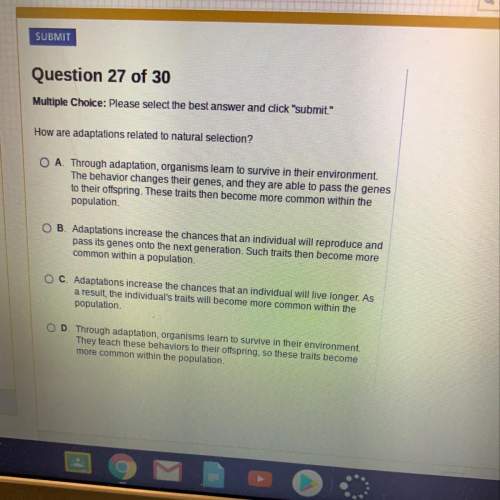
Biology, 24.03.2021 22:10 batmanmarie2004
About 96% of sea water is made of: A. Nitrogen/ B. Carbon dioxide/ C. Sodium and chloride/ D. Hydrogen and oxygen

Answers: 2


Another question on Biology

Biology, 22.06.2019 01:30
Scenario 5 1) take 10 red and 10 black beans and place them, mixed, on the table. record the starting phenotype # and frequencies (% of your total population) of your starting population in the table provided (generation 0). 2) act as a predator. “capture” as many organisms as you can until you have reduced the population to three organisms. put them aside. at this point, the predators die. 3) the remaining organisms each produce 2 clonal offspring. multiply your organisms accordingly and allow them to mix on the table. calculate and record the resultant phenotype # and frequencies (% of your total population) of your population in the table provided (generation 1). 4) repeat the reproduction event, allowing each of your organisms to produce 2 clonal offspring. calculate and record the resultant phenotype # and frequencies (% of your total population) of your population in the table provided (generation 2). 5) repeat the reproduction event, allowing each of your organisms to produce 2 clonal offspring. calculate and record the resultant phenotype # and frequencies (% of your total population) of your population in the table provided (generation 3).
Answers: 1

Biology, 22.06.2019 07:30
Directions: read the descriptions of the four islands presented in the lesson. 1. list two new traits that each new species of rat might demonstrate as it adapts to the conditions on each island. 2. introduce one of the four new rat species to another island and describe one challenge it would encounter and one success as it adapts to its new environment.
Answers: 2

Biology, 22.06.2019 11:30
One of the newest applications of cell technology is called cybrid embryos. this process involves replacing the nuclear material of an animal cell with human nuclear material. how might this process affect public policies about research by using stem cells? the same policies and concerns about the use of human embryonic stem cells would most likely apply. the embryos would most likely be treated like traditional animal embryos and regulated accordingly. the process of forming cybrid embryos would most likely be banned by government regulators. the embryos would be treated as regular cells because they are not fully human in origin.
Answers: 2

Biology, 22.06.2019 19:30
Based on the data in the graphs do you think pepsin and trypsin are found in the same part of the body? explain your answer.
Answers: 2
You know the right answer?
About 96% of sea water is made of: A. Nitrogen/ B. Carbon dioxide/ C. Sodium and chloride/ D. Hydrog...
Questions


Mathematics, 27.10.2020 20:40


Spanish, 27.10.2020 20:40

Physics, 27.10.2020 20:40

Mathematics, 27.10.2020 20:40

English, 27.10.2020 20:40


Mathematics, 27.10.2020 20:40

Mathematics, 27.10.2020 20:40







Biology, 27.10.2020 20:40


History, 27.10.2020 20:40

Mathematics, 27.10.2020 20:40




